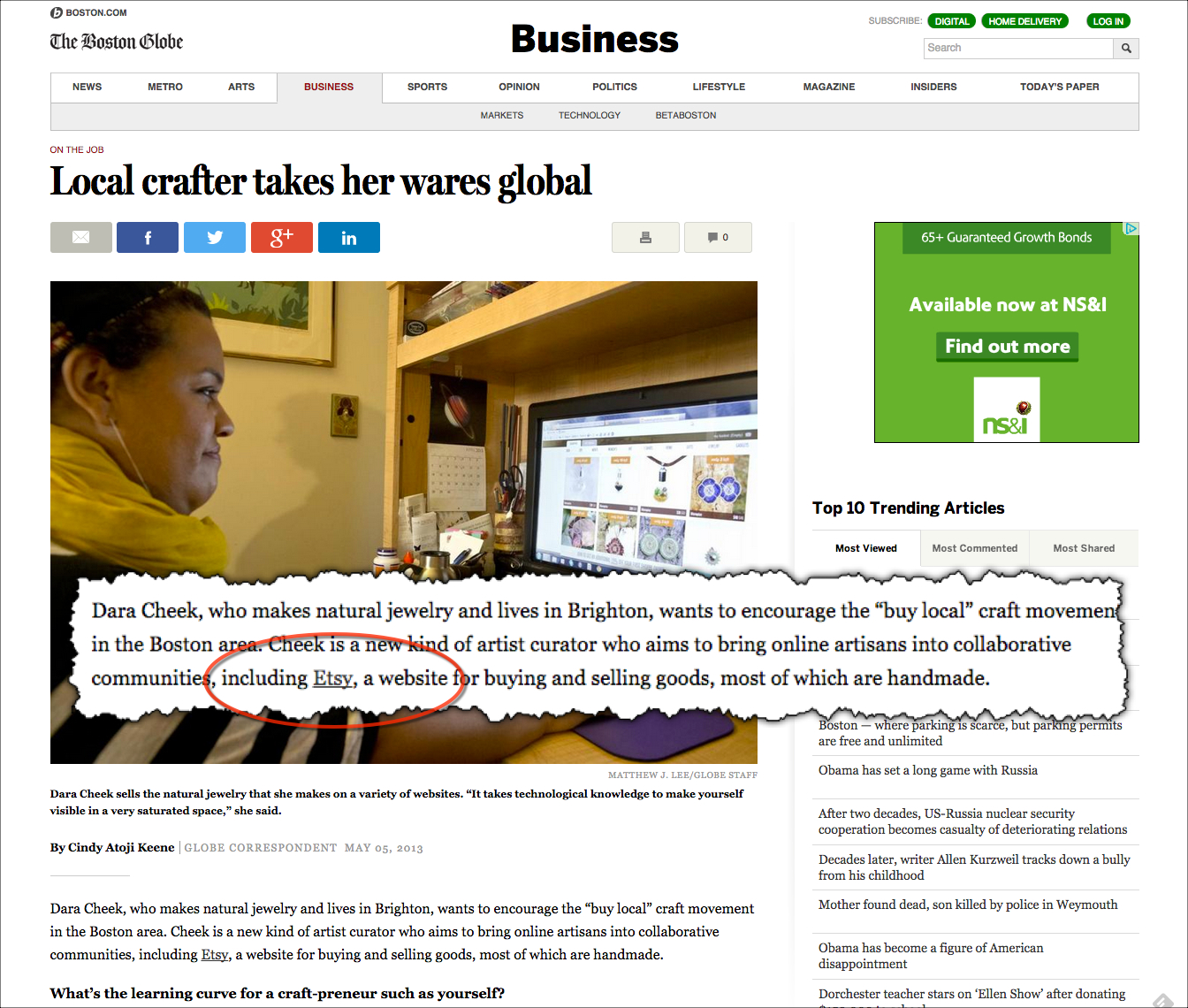
This is a post from our Director of PR Services, Ken McGaffin. You can follow him on Twitter here, and (virtually) meet him in our Webinar on PR Editorial Links.
—-
Media stories have recognizable patterns that appear time and again in all sorts of outlets. Learn what they are, use them to tell your own PR stories and you’ll create pitches that resonate with journalists – and that increases your chances of coverage.
Previously, I described 6 Archetypal Stories in “How Online PR is a Powerful Link Building Tool” and here are another 6 to add to the list:
- Business wins international sales
- Journalist writes overview of a topic
- Results of a survey
- Solution to a health problem
- An unusual or successful promotional campaign
- A ‘top’ list
Here are the stories:
7. Business wins international sales
Winning international business makes a great story – but especially if it’s a small company that’s breaking new ground.
In this Boston Globe article, “Local crafter takes her wares global”, Etsy.com, the craft marketplace, gets an editorial link because one of their craft producers has cracked international sales.
The important point here is that the story is not about Etsy.com per se – it’s about one of their users who achieved success through their marketplace.
The focus of the story is on a small craft business owned by Dara Creek who sells her stuff through Etsy.com. But while Dara Creek is the headline story, the editorial link goes to Etsy. The fact that the business is local was obviously important to the journalist.
So in essence, Etsy.com takes a back seat and lets one of their customers share the limelight. They provide a local example of how a small business has used their services – and that’s a strategy that could be applied in other local markets.
Could you do the same with your customers?
8. Journalist writes overview of a topic
Overview stories typically feature and link to a number of businesses who are used to discuss or explore a particular topic.
In this article in the New York Times, “As Start-Up Strategies Evolve, So Does Role of a Business Plan”, journalist Eilene Zimmerman writes about the changing role of a business plan.But she doesn’t start off with an introduction to what business plans are and how they’re created. Instead she kicks off with a personal story:
“When Joanna Elkayam was laid off from a job selling bonds at Fidelity Investments in 2011, she had been working on a business plan for months. She wanted to open a spa with her husband, Avi, who already owned a successful hair salon.”
Why does she use a personal story rather than explain about business plans?
Because people are interested in people.
The opening story hooks you – you want to know what happened to Joanna and her husband, Avi. The opening draws you in to the rest of the story.
So what triggers an ‘overview’ story?
There are a number of ways:
- Journalist gets a press release and decides to do a wider story – they’re likely to do a search on Google to find other companies to feature or put out a query on HARO
- Journalist is given a brief by the editor – again, this can lead to a Google search or a HARO query
- The journalist has been intending to do this story for a while – they’ve probably been collecting material for a while. But could you have anticipated the story from reading their past articles? If so, you could pitch them a story you know they’re interested in.
So such a story could be the result of a press release from one of the companies involved – and other companies could be featured because the reporter used Google to find more examples to create a balanced story.
9. Results of a survey
Survey results are a perennial favorite with journalists and publications of all kinds. Like in this story on NBC, How to Nail a Job Interview and Avoid Embarrassing First Impressions
This article refers to a survey by CareerBuilder.com. While surveys do get coverage, there are many surveys that do not. You survey must:
- be related to the business you run
- focus on an interesting topic – in this case body language in interviews
- not be overtly self-serving
- show that the research has been conducted properly
- provide something to link to – you won’t always get a link BUT if you provide something compelling like a survey report or summary, you’ll increase your chances of getting that nice editorial link – in this case NBC linked to http://www.careerbuilder.com/share/aboutus/pressreleasesdetail.aspx
Surveys may or may not give you coverage – so it’s important that they’re of benefit to your business, even if they don’t get covered. Remember, you can get real insight into your customers, you can encourage testimonials and ideas for new products.
10. Solution to a health problem
This could be the most popular archetypal story.
We’re all a bit obsessed about our health, and if you can show the real health benefits of your products or services, you can grab yourself some coverage.
In this article, “Your Desk Will Save You. Here’s How”, Dr. Mark Benden, one of the nation’s top ergonomists, explains some of the research and product development he’s conducting.
One of the highlights of the article, is Dr. Benden’s mission which is featured right at the top of the article: “This ergonomist has a mission: to design an office that’s scientifically proven to boost your fitness, mental health, and productivity.”
By clearly stating your mission in a way that is meaningful to your customers and potential customers, you’ll stand out from many other businesses – it might just be the thing that makes the difference between the journalist running the story or not.
11. An unusual or successful promotional campaign
The ads and messages we’re bombarded with daily have a great following already, and a particularly novel or controversial story can grab a lot of attention and even go viral.
This one from Always really struck a chord when it explored the phrase “like a girl” and what it really means in our culture. It’s a brilliant piece of work with a strong social message.
Done well, this can have a really big ROI. This story really hit the mark on http://www.elephantjournal.com/2014/06/as-a-male-this-is-the-first-tampon-commercial-that-actually-moved-me/

One of the things that stood out in this piece was a quote taken from social media – “As a male, this is the first tampon commercial that actually ‘moved’ me.”
12. A ‘top’ list
This type of story will be no stranger to link builders – but one of the problems can be coming up with good, unique ideas for topics. But what if your business is sitting on a ton of information that no-one else has?
Then you can create really unique content.
That’s the trick that FlexJobs.com pulled off when they got this story on SFGate.com,
“10 highest-paying work-from-home jobs”.
The company was able to isolate ‘work from home’ jobs that paid over $90,000. They found that there were a lot of high paying jobs that could be done at home.
Their news was able to debunk a myth. “One of the big misconceptions about work from home jobs is that they don’t pay well,” Sara Sutton Fell, CEO of FlexJobs, said in a statement. “The examples below are just a handful of high salary jobs available in the flexible marketplace.”
Does your business have access to a large database of customer data? Can you analyse it to produce newsworthy statistics?
How can you use these archetypal stories?
- Explore how each of these archetypes could be applied to your business
- Don’t ignore archetypes that you think “will never work in my business!” – go beyond your usual thinking, be a little crazy and have some fun.
- Don’t just copy ideas you like, develop the idea and add your own unique twist
- Look at the news you consume every day – can you build your own collection of archetypes? (and please share them below!)
That’s it for now!
Be sure to watch out for our next live Online PR Brainstorm where Garrett and I will be answering your questions live. And if you’ve got a PR problem you’re grappling with, or if you’d like some advice for a project you’re working on, then let us know – we might just feature you on the show!




